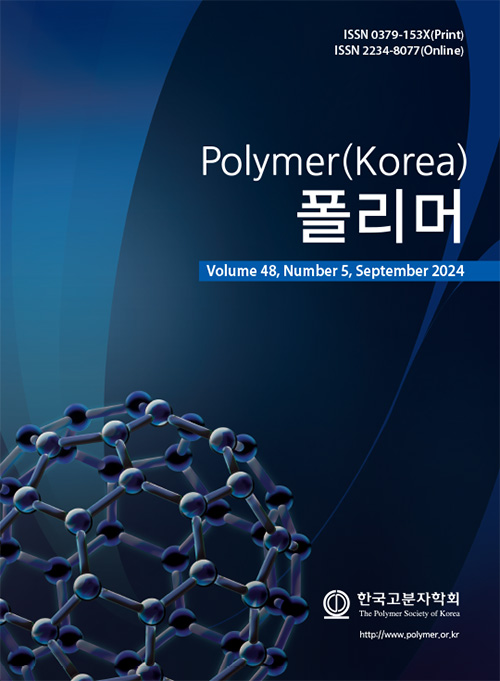- Impact of Simultaneous Silane and PCPA Grafting on the Thermal and Mechanical Properties of BN and GO Hybrid Composites
Youngsung Cho*,# , Jihoon Kim*,# , Jangwoo Cho*, and Jooheon Kim*, **,†

*Departement of Chemical Engineering, Chung-Ang University, 84 Heukseok-ro, Dongjak-gu, Seoul 06974, Korea
**Department of Intelligent Energy and Industry, Graduate School, Chung-Ang University, Seoul 06974, Korea- 실란과 PCPA 그래프팅의 동시적인 영향이 BN 및 GO 하이브리드 복합체의 열 및 기계적 특성에 미치는 영향
*중앙대학교 화학공학과, **중앙대학교 대학원 지능형에너지산업학과
Reproduction, stored in a retrieval system, or transmitted in any form of any part of this publication is permitted only by written permission from the Polymer Society of Korea.
In this study, we developed highly thermally conductive composites using boron nitride (BN) and graphene oxide (GO) hybrid fillers. By employing a simultaneous grafting procedure involving poly(catechol/polyamine) (PCPA) and silane fillers, we enhanced the thermal and mechanical properties of an epoxy polymer. Surface treatments with (3-glycidyloxypropyl)trimethoxysilane (GPTMS), polycatechol, and tetraethylenepentamine minimized filler aggregation within the resin matrix. The resulting surface-treated hybrid composite exhibited a remarkable 2252% increase in thermal conductivity (4.83 Wm-1K-1) compared to the base matrix. This improvement was achieved by incorporating 50 wt% surface-treated BN, 5 wt% surface-treated GO, and PCPA and GPTMS treatments. In contrast, composites containing raw fillers demonstrated lower thermal conductivity (3.37 Wm-1K-1). The surface-treated filler-contained composites also showed superior mechanical properties. The advantages of this surface treatment, combined with the straightforward thermal curing procedure involving PCPA and GPTMS, offer a convenient and rapid solution for heat dissipation challenges in electronic packaging materials.
본 연구에서는 붕화붕소(BN) 및 그래핀 산화물(GO) 하이브리드 필러를 사용하여 고열전도성 복합체를 개발하였다. 폴리(카테콜/폴리아민)(PCPA) 및 실란 필러를 동시 그래프팅하는 절차를 채택하여 에폭시 중합체의 열 및 기계적 특성을 향상시켰다. (3-글리시디록시프로필)트리메톡시실란(GPTMS), 폴리카테콜 및 테트라에틸렌펜타민을 사용한 표면 처리는 수지 매트릭스 내 필러 응집을 최소화했다. 결과물로 나온 표면 처리된 하이브리드 복합체는 기본 매트릭스와 비교하여 열 전도도가 놀라운 2252% 증가한 것으로 나타났다(4.83 Wm-1K-1). 이 향상은 50 wt% 표면 처리된 BN, 5 wt% 표면 처리된 GO, 그리고 PCPA 및 GPTMS 처리를 포함하여 구현되었다. 반면, 날 것의 필러를 함유하는 복합체는 열 전도도가 낮았다(3.37 Wm-1K-1). 표면 처리된 필러 함유 복합체는 또한 우수한 기계적 특성을 나타냈다. 이러한 표면 처리의 장점과 PCPA 및 GPTMS를 이용한 간편한 열 가공 절차는 전자 패키지 재료의 열 분산 문제에 대한 편리하고 신속한 해결책을 제공한다.
Keywords: thermal conductivity, mechanical property, surface treatment
- Polymer(Korea) 폴리머
- Frequency : Bimonthly(odd)
ISSN 0379-153X(Print)
ISSN 2234-8077(Online)
Abbr. Polym. Korea - 2023 Impact Factor : 0.4
- Indexed in SCIE
 This Article
This Article
-
2024; 48(5): 543-552
Published online Sep 25, 2024
- 10.7317/pk.2024.48.5.543
- Received on Apr 29, 2024
- Revised on May 23, 2024
- Accepted on May 28, 2024
 Correspondence to
Correspondence to
- Jooheon Kim
-
*Departement of Chemical Engineering, Chung-Ang University, 84 Heukseok-ro, Dongjak-gu, Seoul 06974, Korea
**Department of Intelligent Energy and Industry, Graduate School, Chung-Ang University, Seoul 06974, Korea - E-mail: jooheonkim@cau.ac.kr








 Copyright(c) The Polymer Society of Korea. All right reserved.
Copyright(c) The Polymer Society of Korea. All right reserved.